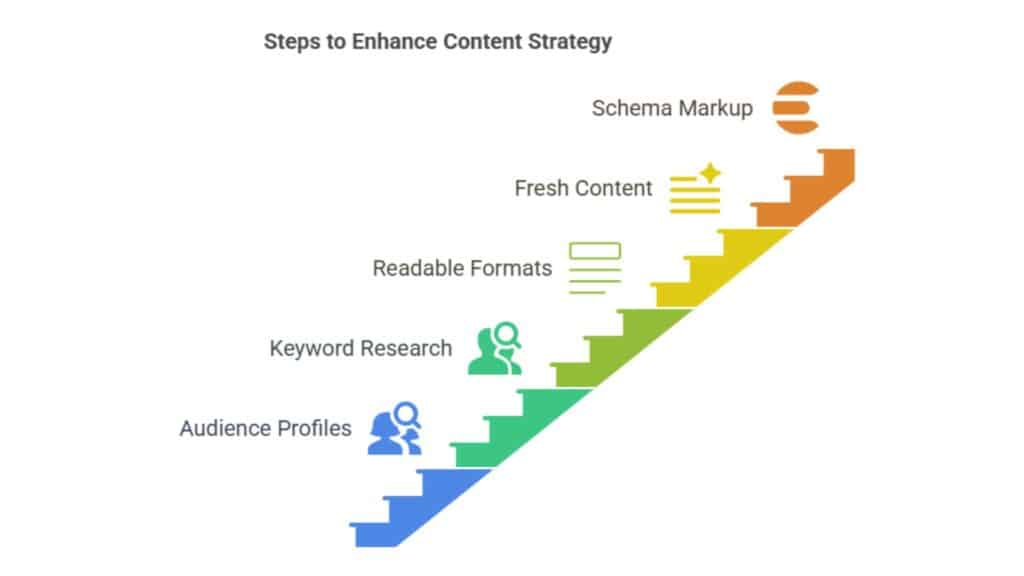
Top 10 SEO Tips for Effective Blog Content
Creating blog content with SEO in mind requires thoughtful planning and smart execution. Start by developing SEO personas to ensure your content speaks directly to your audience’s needs. Build a strong keyword strategy by choosing target and long-tail keywords that match what people are searching for. Use clear headings, lists, and a well-organized structure to make your content easy to read. Focus on evergreen topics that stay relevant over time and encourage user interaction with features like comments or polls. Regularly update your posts with fresh information and optimized images or videos to keep them current. Use internal and external links to build credibility, and don’t forget to optimize for featured snippets and add schema markup to boost your blog’s visibility. These strategies can help take your blog’s SEO to the next level and help you know how to optimize blog posts for SEO!
Key Takeaways
- Create audience profiles: Get to know your audience by building detailed personas so you can tailor your content to their interests and keep them engaged.
- Do smart keyword research: Find the keywords your audience is searching for to help your content stand out in search results and reach more people.
- Use easy-to-read formats: Organize your content with clear headings and simple lists, making it easier for your readers to follow and enjoy.
- Keep content fresh: Regularly update old posts with new information and current keywords to stay relevant and keep your site optimized.
- Use schema markup: Make it easier for search engines to understand and showcase your content, boosting your visibility in search results.

1. Create SEO personas

To effectively enhance your blog’s search engine optimization, it is crucial to create SEO personas. These personas serve as detailed representations of your ideal audience, allowing you to tailor your content with precision. Understanding your audience through the lens of SEO personas enables you to implement audience segmentation effectively, thereby ensuring that your content reaches the right people. This approach helps in crafting content that resonates with specific user groups based on their behaviors, preferences, and needs.
The process of creating SEO personas involves demographic targeting, which includes identifying characteristics such as age, gender, location, and interests. By doing so, you can tailor your blog content in a way that speaks directly to these groups. This targeted approach not only enhances engagement but also increases the likelihood of converting visitors into loyal readers.
Moreover, SEO personas aid in content personalization. When you understand the user intent behind search queries, you can create content that aligns with what your audience is actively seeking. This alignment increases the relevance of your blog in search engine results, improving your visibility and authority.
It is essential to continuously refine your SEO personas to adapt to changing trends and audience behaviors. Regularly analyze data to ensure your personas remain accurate and relevant. This ongoing process will help maintain your blog’s competitive edge in the digital landscape.
2. Select Target Keywords

Identifying and selecting target keywords is a fundamental step in optimizing your blog content for search engines. A well-chosen set of keywords not only enhances your content’s visibility but also aligns it with the search intent of your audience. To achieve this, employing keyword research tools is indispensable. These tools provide valuable insights into search volume, competition, and potential keyword variations. By analyzing this data, you can identify keywords that resonate with your target audience while maintaining a balance between competitiveness and search volume.
Incorporating competitor analysis strategies into your keyword selection process offers a competitive edge. By examining the keywords your competitors are ranking for, you can uncover gaps and opportunities in your own content strategy. This analysis can reveal niche areas where your blog can outperform others, positioning your content more effectively in search engine results.
Effective keyword placement techniques are crucial for maximizing the impact of your chosen keywords. They should be strategically integrated into key elements of your blog, such as the title, headers, and meta descriptions, ensuring that search engines accurately index your content.
Additionally, the use of local SEO keywords can be particularly beneficial for businesses aiming to attract local audiences. These keywords focus on regional search terms, helping to drive traffic from specific geographic areas.
3. Add Headings and Lists

Enhancing the readability and structure of your blog content can significantly improve user engagement and search engine optimization. One effective method to achieve this is by utilizing strategic headings and lists, which play a crucial role in organizing content and catering to both human readers and search engine algorithms.
The adoption of a well-defined header hierarchy greatly impacts the content structure, guiding readers through the material in a logical and accessible manner. This hierarchy, typically involving H1 for the main heading, H2 for subheadings, and H3 for further subdivision, helps search engines understand the importance and relationships between different sections of your content. By clearly outlining topics and subtopics, headers not only contribute to improved SEO but also enhance the user experience by breaking the text into manageable parts.
Moreover, list formatting is another powerful tool for improving readability factors. Lists, whether ordered or unordered, can distill complex information into digestible points, making it easier for readers to absorb key messages quickly. Incorporating bullet points or numbers into your blog content not only increases visual appeal but also assists users in skimming the text for pertinent information, thus keeping them engaged.
Incorporating these elements into your blog content not only aids in organizing information but also enhances visual appeal, making your posts more inviting and easier to navigate. By focusing on a robust content structure, featuring a clear header hierarchy and effective list formatting, you create a harmonious balance between aesthetic presentation and functional design. This fosters a more satisfying experience for your audience and improves your blog’s SEO performance.
4. Write Evergreen Content

Building upon the importance of structured content with strategic headings and lists, another key aspect of effective blog writing is the creation of evergreen content.
Evergreen content refers to blog posts that remain relevant and valuable over long periods. This type of content is crucial for maintaining consistent traffic and engagement, as it is not tied to fleeting trends or temporary topics.
To effectively craft such content, consider the following steps:
- Select Timeless Topics: The foundation of evergreen content lies in selecting topics that are not only relevant today but will continue to be significant in the future. This requires thorough audience research to understand the enduring interests and needs of your readers.
- Optimize Content Structure: A well-organized content structure enhances readability and ensures that your evergreen content remains accessible. Use clear headings, bullet points, and concise paragraphs to allow readers to easily navigate and digest the information.
- Adapt Writing Style and Distribution Channels: Writing style should be straightforward and free from jargon, ensuring that your message is understood by a broad audience.
Additionally, leverage various distribution channels to maximize reach and engagement. By sharing content across platforms like social media, newsletters, and forums, you can extend its lifespan and continually attract new audiences.
5. Use Long-tail Keywords
Incorporating long-tail keywords into your blog content is a strategic approach to enhance search engine optimization and attract targeted traffic. Unlike short-tail keywords, long-tail keywords are more specific phrases that better capture user intent. This specificity not only aligns with what potential readers are genuinely searching for but also improves the likelihood of your content appearing in relevant search results.
By understanding user intent, you can craft content that directly addresses the needs and questions of your audience, thereby increasing content relevance and engagement. The process begins with thorough keyword research. Identifying long-tail keywords involves analyzing search volume and competitive analysis to ensure that the phrases selected are not only frequently searched but also less competitive.
This balance is crucial; high search volume alone is insufficient if the competition is too fierce. Conversely, lower competition keywords can significantly enhance your chances of ranking higher in search engine results pages (SERPs). Content relevance is another critical factor. Your blog should seamlessly integrate these long-tail keywords in a manner that feels natural and enhances the reader’s experience.
This means avoiding keyword stuffing and instead weaving the keywords into your content organically. This approach not only helps in achieving higher search rankings but also ensures that your content remains valuable and informative to the reader.
6. Update Outdated Content

Regularly updating outdated content is a fundamental strategy for maintaining the relevance and authority of your blog. As the digital landscape evolves, so does the information that your audience seeks. To keep your blog valuable and engaging, it’s crucial to implement effective refresh strategies. Here’s how you can ensure your content remains up-to-date:
- Conduct Regular Content Auditing: Periodically assess your blog for outdated or underperforming content. Utilize SEO tools to identify pages that require attention based on performance metrics such as traffic, bounce rate, and engagement. This systematic approach will help pinpoint areas needing improvement.
- Implement Refresh Strategies: Once you’ve identified outdated content, update it with current information, new insights, and relevant keywords. This not only enhances the quality of the content but also boosts its visibility in search engines. Ensure that the refreshed content aligns with your audience’s current interests and industry trends.
- Leverage Audience Feedback: Engage with your readers to understand what they find helpful or lacking in your content. Audience feedback can provide valuable insights into areas that need updating or expanding. By responding to their needs, you foster a more loyal readership and enhance your blog’s authority.
Incorporating these strategies ensures that your blog remains a credible source of information. By continuously updating your content, you not only improve its SEO performance but also demonstrate a commitment to providing your audience with the most accurate and relevant information.
This practice not only bolsters your blog’s search engine rankings but also strengthens its position as a trusted resource.
7. Add Optimized Images and Videos

Visual engagement is a powerful tool in elevating the quality and reach of your blog content. Incorporating optimized images and videos not only enhances the aesthetic appeal but also significantly boosts SEO performance. To achieve this, applying effective image compression techniques is crucial. Compressing images reduces file sizes without compromising quality, resulting in faster page load times, which is a key ranking factor for search engines. Tools like TinyPNG and JPEGmini can facilitate this process.
In parallel, video SEO strategies are essential for maximizing the visibility of video content. This includes crafting compelling titles and descriptions that incorporate relevant keywords, ensuring your video content aligns with user intent. Additionally, hosting videos on platforms like YouTube can extend reach while embedding them into your blog fosters engagement and dwell time.
Another critical component is the alt text importance for images and video transcripts. Alt text provides a textual alternative to visual content, aiding search engines in understanding the context while improving accessibility for users with visual impairments. Well-crafted alt text should be concise yet descriptive, incorporating keywords naturally.
Furthermore, embracing multimedia storytelling can captivate audiences and convey complex messages more effectively. This approach integrates images, videos, and text to create a cohesive narrative that resonates with viewers.
Keeping abreast of visual content trends is also advantageous. As user preferences evolve, adapting your visual strategy can maintain relevance and encourage continued engagement. Whether it’s through infographics or interactive videos, staying informed ensures your content remains dynamic and appealing in an ever-changing digital landscape.
8. Link to Relevant Site Content

A strategic approach to linking relevant site content can significantly enhance the SEO performance of your blog. When executed effectively, internal linking strategies can guide your readers through a logical flow of information, thereby increasing their time on site and reducing bounce rates.
Additionally, these links help search engines understand the structure of your content, enhancing content relevance scoring and boosting your SEO rank.
To maximize the potential of linking to relevant content, consider the following steps:
- Utilize Internal Linking Strategies: Carefully select and place internal links within your blog posts to connect related topics. This not only aids in seamless navigation but also signals the importance of certain pages to search engines.
By strategically choosing which pages to link to, you can highlight key content and improve overall user experience.
- Leverage Outbound Link Benefits: While internal links are crucial, incorporating outbound links to authoritative sources can improve your blog’s credibility. By linking to reputable external sites, you provide additional context and depth to your content, which can enhance your page’s trustworthiness in the eyes of search engines.
- Focus on Anchor Text Optimization: The choice of anchor text is critical in your link building techniques. Ensure that your anchor text is descriptive and relevant to the content it leads to.
This optimization not only improves user experience but also helps search engines understand the context and relevancy of your links.
9. Encourage User Engagement

Fostering user engagement is a crucial component of effective blog content that can significantly impact both user experience and SEO performance. When readers actively participate in your blog, they spend more time on the page, which positively influences search engine rankings.
One of the most direct ways to boost engagement is through a well-maintained comment section. Encouraging thoughtful discussions and responding promptly to comments can create a lively forum for reader interaction and feedback, enhancing the sense of community around your blog.
Interactive polls are another excellent tool for engaging readers. By posing questions related to your content, you invite readers to express their opinions, which not only keeps them involved but also provides you with valuable insights into your audience’s preferences and interests.
This data can guide future content creation, ensuring that your blog remains relevant and engaging.
Social sharing buttons should be strategically placed to facilitate the easy dissemination of your content across various platforms. When readers share your posts, it increases your blog’s visibility and potentially broadens your audience.
Each share acts as an endorsement, increasing the likelihood of attracting new readers who may become part of your growing community.
10. Optimize for Featured Snippets
Building on the importance of user engagement, another strategic approach to enhance your blog’s visibility is by optimizing for featured snippets. Featured snippets are concise information boxes that appear at the top of Google’s search results, providing users with quick answers.
To successfully optimize for these snippets, consider the following strategies:
- Question Targeting: Begin by identifying common questions your audience might ask related to your content. Use keyword research tools to discover these queries and incorporate them naturally into your content. Crafting your content around question targeting can improve the likelihood of your blog being selected for a featured snippet.
- Snippet Formatting: Structure your content using the right snippet formatting. This involves presenting information in a clear and organized manner, such as using bullet points, numbered lists, or tables. Such formats are often favored by search engines for answer boxes, increasing the chance of your content being highlighted.
- Content Hierarchy: Employ a logical content hierarchy to ensure clarity and accessibility. This means organizing your content with headers and subheaders (e.g., H2, H3) to break down complex information into digestible sections. This not only enhances readability but also aids search engines in understanding your content’s structure.
Additionally, integrating schema markup can further boost your chances of being featured. Schema markup provides search engines with context about your content, making it easier for them to select it for snippets.
Final Thoughts
Incorporating these top 10 SEO tips for effective blog content can significantly enhance your blog’s visibility, engagement, and search engine ranking. From creating SEO personas and performing keyword research to updating content and optimizing for snippets, each step plays a crucial role in building a well-rounded SEO strategy.
Looking for expert help to take your blog’s SEO to the next level? Connect with Syville Gacutan, a seasoned SEO Specialist in the Philippines. Syville can guide you in optimizing your blog, enhancing search visibility, and driving consistent traffic. Don’t miss out on the opportunity to grow your blog’s reach – contact Syville today!